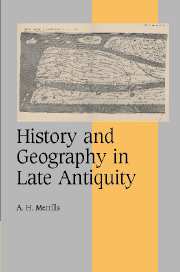Book contents
- Frontmatter
- Contents
- Preface
- A note on translations
- List of abbreviations
- Introduction: history's other eye
- 1 Orosius
- 2 Jordanes
- 3 Isidore of Seville
- 4 Bede
- 5 Conclusions
- Appendices
- A The geographical introduction to the Historiarum adversus paganos libri septem of Orosius. Orosius, Hist. i.1–106
- B The geographical introduction to the De origine actibusque Getarum of Jordanes. Getica i.4–v.38.
- C The Laus Spaniae of Isidore of Seville
- D The description of Britain in Bede, Historia Ecclesiasticai.1
- References
- Index
- Cambridge Studies in Medieval Life and Thought Fourth series
B - The geographical introduction to the De origine actibusque Getarum of Jordanes. Getica i.4–v.38.
Published online by Cambridge University Press: 24 July 2009
- Frontmatter
- Contents
- Preface
- A note on translations
- List of abbreviations
- Introduction: history's other eye
- 1 Orosius
- 2 Jordanes
- 3 Isidore of Seville
- 4 Bede
- 5 Conclusions
- Appendices
- A The geographical introduction to the Historiarum adversus paganos libri septem of Orosius. Orosius, Hist. i.1–106
- B The geographical introduction to the De origine actibusque Getarum of Jordanes. Getica i.4–v.38.
- C The Laus Spaniae of Isidore of Seville
- D The description of Britain in Bede, Historia Ecclesiasticai.1
- References
- Index
- Cambridge Studies in Medieval Life and Thought Fourth series
Summary
TRANSLATION TAKEN FROM CHARLES C. MIEROW, THE GOTHIC HISTORY OF JORDANES (PRINCETON, NJ, 1915), PP. 52–60
I (4) Our ancestors, as Orosius relates, were of the opinion that the circle of the whole world was surrounded by the girdle of Ocean on three sides. Its three parts they called Asia, Europe and Africa. Concerning this threefold division of the earth's extent there are almost innumerable writers, who not only explain the situations of cities and places, but also measure out the number of miles and paces to give more clearness. Moreover they locate the islands interspersed amid the waves, both the greater and also the lesser islands, called Cyclades or Sporades, as situated in the vast flood of the Great Sea.
(5) But the impassable farther bounds of Ocean not only has no one attempted to describe, but no man has been allowed to reach; for by reason of obstructing seaweed and the failing of the winds it is plainly inaccessible and is unknown to any save to Him who made it.
(6) But the nearer border of this sea, which we call the circle of the world, surrounds its coasts like a wreath. This has become clearly known to men of inquiring mind, even to such as desired to write about it. For not only is the coast itself inhabited, but certain islands off in the sea are habitable. Thus there are to the East in the Indian Ocean, Hippodes, Iamnesia, Solis Perusta (which though not habitable is yet of great length and breadth), besides Taprobane, a fair island wherein there are towns or estates and ten strongly fortified cities. But there is yet another, the lovely Silefantina, and Theros also.
[…]
- Type
- Chapter
- Information
- History and Geography in Late Antiquity , pp. 321 - 326Publisher: Cambridge University PressPrint publication year: 2005



